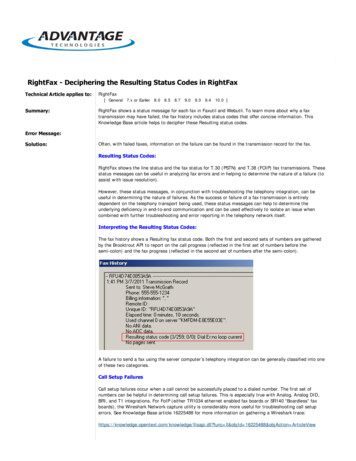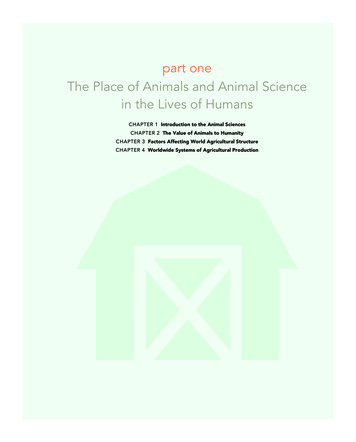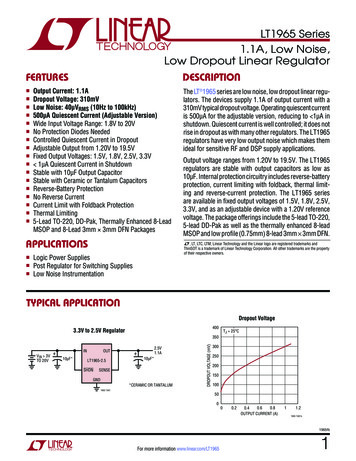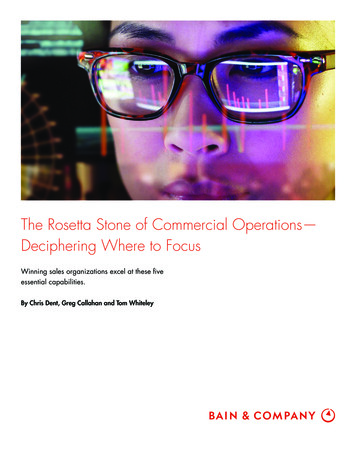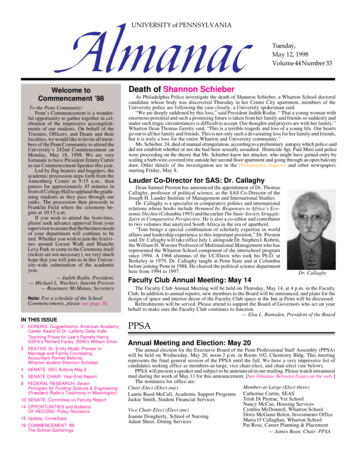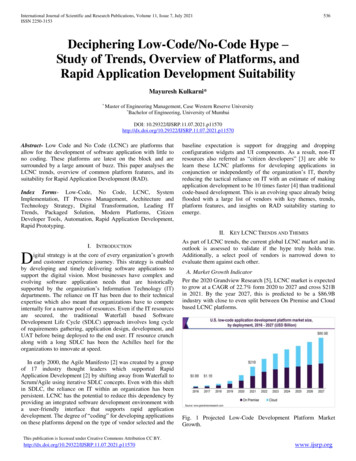
Transcription
International Journal of Scientific and Research Publications, Volume 11, Issue 7, July 2021ISSN 2250-3153536Deciphering Low-Code/No-Code Hype –Study of Trends, Overview of Platforms, andRapid Application Development SuitabilityMayuresh Kulkarni** Masterof Engineering Management, Case Western Reserve University*Bachelor of Engineering, University of MumbaiDOI: 10.29322/IJSRP.11.07.2021.p11570Abstract- Low Code and No Code (LCNC) are platforms thatallow for the development of software application with little tono coding. These platforms are latest on the block and aresurrounded by a large amount of buzz. This paper analyses theLCNC trends, overview of common platform features, and itssuitability for Rapid Application Development (RAD).Index Terms- Low-Code, No Code, LCNC, SystemImplementation, IT Process Management, Architecture andTechnology Strategy, Digital Transformation, Leading ITTrends, Packaged Solution, Modern Platforms, CitizenDeveloper Tools, Automation, Rapid Application Development,Rapid Prototyping.baseline expectation is support for dragging and droppingconfiguration widgets and UI components. As a result, non-ITresources also referred as “citizen developers” [3] are able tolearn these LCNC platforms for developing applications inconjunction or independently of the organization’s IT, therebyreducing the tactical reliance on IT with an estimate of makingapplication development to be 10 times faster [4] than traditionalcode-based development. This is an evolving space already beingflooded with a large list of vendors with key themes, trends,platform features, and insights on RAD suitability starting toemerge.II. KEY LCNC TRENDS AND THEMESI. INTRODUCTIONigital strategy is at the core of every organization’s growthand customer experience journey. This strategy is enabledby developing and timely delivering software applications tosupport the digital vision. Most businesses have complex andevolving software application needs that are historicallysupported by the organization’s Information Technology (IT)departments. The reliance on IT has been due to their technicalexpertise which also meant that organizations have to competeinternally for a narrow pool of resources. Even if the IT resourcesare secured, the traditional Waterfall based SoftwareDevelopment Life Cycle (SDLC) approach involves long cycleof requirements gathering, application design, development, andUAT before being deployed to the end user. IT resource crunchalong with a long SDLC has been the Achilles heel for theorganizations to innovate at speed.DIn early 2000, the Agile Manifesto [2] was created by a groupof 17 industry thought leaders which supported RapidApplication Development [2] by shifting away from Waterfall toScrum/Agile using iterative SDLC concepts. Even with this shiftin SDLC, the reliance on IT within an organization has beenpersistent. LCNC has the potential to reduce this dependency byproviding an integrated software development environment witha user-friendly interface that supports rapid applicationdevelopment. The degree of “coding” for developing applicationson these platforms depend on the type of vendor selected and theAs part of LCNC trends, the current global LCNC market and itsoutlook is assessed to validate if the hype truly holds true.Additionally, a select pool of vendors is narrowed down toevaluate them against each other.A. Market Growth IndicatorPer the 2020 Grandview Research [5], LCNC market is expectedto grow at a CAGR of 22.7% form 2020 to 2027 and cross 21Bin 2021. By the year 2027, this is predicted to be a 86.9Bindustry with close to even split between On Premise and Cloudbased LCNC platforms.Fig. 1 Projected Low-Code Development Platform MarketGrowth.This publication is licensed under Creative Commons Attribution CC 570www.ijsrp.org
International Journal of Scientific and Research Publications, Volume 11, Issue 7, July 2021ISSN 2250-3153B. Comparison of LCNC Growth with Other LeadingTechnology TrendsFor the purposes of this analysis, LCNC growth is comparedagainst AI, Blockchain, Edge Computing, and RPA. Also, toensure research consistency, the analyses refer market reportsfrom a common vendor. [5],[6],[7],[8],[9].* Market Size for 2027Fig. 2 LCNC Global Market Size Vs. Other Leading Trends.While the growth for LCNC has been unprecedented, it fairsmoderately when stacked against other leading technologytrends. In fact, the CAGR for LCNC is the lowest at 22.7% whencompared to others signifying interplay with other trends e.g., AIand RPA platforms potentially chipping away some of the LCNCmarket cap.C. Leading LCNC Platforms Based on Analyst ReportsOver 300 vendors are estimated [10] to cater the LCNC market.While it is not possible to cover all of them, some of the vendorsrepeatedly rise above the others in the pack across the 3 analystreports. The below table illustrates these select leading LCNCvendors [5], [11], [12].LCNC VendorsAppianMendixMicrosoft Power ster's ReportStrong PerformerLeaderLeaderLeaderStrong PerformerStrong PerformerLeaderGartner's rGrand View's ReportProminent PlayerProminent PlayerProminent PlayerProminent PlayerProminent PlayerProminent PlayerProminent PlayerTable. 1 Leading LCNC Platforms.D. Funding & Market Capitalization of Leading LCNCVendorsAt least 800M is raised by group of vendors listed below. [13],[14], [15], 16], [17]LCNC VendorsFunding RaisedAppian 48MMendix 38MMicrosoft Power AppsN/AOutSystems 572MPegasystemsN/ASalesforce 65MServiceNow 84M 807MMarket Cap 9.5B 0.7BN/A 9.5B 11.0B 230.0B 110.9B 361B537Market Cap is based on the stock price on July 7th, 2021 forpublicly traded firms. Since Mendix and OutSystems are nottraded, valuation is used for comparison purposes [18], [19]. Thetotal valuation of this pool of vendors exceeds 361B. Thisnumber will be significantly higher when factored for the 300vendors estimated [10] to cater this segment and willsignificantly flood the market. Even with a medium to highCAGR of 22% (Fig 2), LCNC platforms will need to stay laserfocused on their product and market execution strategy to avoidlosing on growth and staying relevant.E. Industry Demographics of the Leading LCNC VendorsConceptually, LCNC can be industry agnostic however someindustries have a higher propensity for being able to leveragethese platforms due to existing legacy technologies that need tobe wrapped around LCNC for creating new application or theirhigher appetite for innovation. This combined with sales andmarketing focus of LCNC vendors paint the picture for theirindustry alignment. The below table is indicative and based onthe population of reviews provided for these vendors by theircustomers. [21], [22], [23], [24], [25], [26].Industry Other31%29%43%35%N/A28%34%Indicates vendor with highest demographic focusTable. 3 Industry Demographics of Leading LCNC Platforms.Geographic DemographicsEurope, MiddleNorth America East, & AN/ASalesforce52%24%16%ServiceNow49%18%25%Latin America4%2%9%6%N/A8%8%Indicates vendor with high demographic focusTable. 4 Geographic Demographics of Leading LCNC Platforms.Services, Finance, and Manufacturing are three primary sectorsproviding traction to LCNC based on Table 3. From a geographicstandpoint and referring to Table 4, Appian, Salesforce, andServiceNow command the North American Market and are USAheadquartered. OutSystems originated in EMEA which led totheir stronghold in this region. Microsoft on the other hand hasmore of a distributed hold across both the industry andgeographic demographics. The above tables are indicative andbased on the population of reviews provide for these vendors bytheir customers. [21], [22], [23], [24], [25], [26].Table. 2 Funding and Market Capitalization of Leading LCNCPlatforms.This publication is licensed under Creative Commons Attribution CC 570www.ijsrp.org
International Journal of Scientific and Research Publications, Volume 11, Issue 7, July 2021ISSN 2250-3153III. LCNC PLATFORM OVERVIEWA. Key LCNC Platform FeaturesThere are few common native core features that most LCNCplatforms support. The maturity levels of these features do varybased on the platform selected. Below is the high-level overviewof these:1) Developer studio or workbench – An IntegratedDevelopment Environment (IDE) that allows developers tointeract with the LCNC platform to build applications.2) UI components and widgets – UI screen elements andwidgets for visualization that can be dragged and droppedalong with ability to modify HTML and CSS if needed.3) Data integration – Tools for integrating, transposing, andorchestrating the exchange with internal and external datasets.4) Workflows and rules – Configurable workflow and rulesthat allows for application to hand off with either other partsof the application or amongst application users.5) Process automation – Bots and Robotic ProcessAutomation capabilities for assisting with manual andrepeatable processes6) Testing and deployment management – Tools forapplication administration, unit, functional, and integrationtesting, and deployment.7) Application governance – Super admin user tools for rolesbased access management, security settings, privacymanagement, data oversight, performance monitoring, auditlogging, and reporting.538IV. LCNC AND ITS SUITABILITY FORRAPID APPLICATION DEVELOPMENT (RAD)A. LCNC Synergies with RADThe term Rapid Application Development (RAD) [2] was coinedby James Martin in his book Rapid Application Development(RAD). This is an application development lifecycle designed togive much faster development and higher-quality results thanthose achieved with the traditional lifecycle. The advent ofLCNC platforms enable this type of modern applicationdevelopment methodology due to complementary synergiesmainly due to following reasons:1) Learning curve to start building applications is compressedand typically in weeks.2) LCNC platforms provide an integrated environment to theuser that encompasses all the needed technology stacks,which the developer does not need to manage and maintain.3) User story to application build and deployment can be doneby a lean self-sufficient team with limited technical expertisevs. heavy reliance on IT.B. LCNC Representative Technology Components and StackFeatures needed to enable the LCNC platform are supported byan array of technology stacks. These are often a combination ofopen source and licensed technologies which vary from vendorto vendor.[27], [28], [29].Fig. 4 Lean and Self-Sufficient LCNC Development Team.4) Hybrid agile style iterations [30] to develop the applicationwith certainty and specified timeline is possible due toreduced resource constrains as citizen developers shoulderthe heavy lifting while doing so in a shorter build, test, anddeployment cycle.Fig. 3 LCNC Representative Technology Components and Stack.This publication is licensed under Creative Commons Attribution CC 570www.ijsrp.org
International Journal of Scientific and Research Publications, Volume 11, Issue 7, July 2021ISSN 2250-3153[7][8][9]Fig. 5 Hybrid Agile Approach for LCNC Development.[10]B. LCNC Program Blind Spots to Consider While in RADWhile there is strong market demand for LCNC platforms and agreat synergy for RAD, there are few blind spots that everyLCNC program will need to navigate. These are:1) Ensuring the platform fits the objectives and provides scale.Given the over 300 vendors [10] in this space, it is necessarythat appropriate vendor selection is done so avoid futureregrets.2) Not compromising on the security of applications built usingLCNC. This becomes increasingly critical during RAD asthe focus is on building applications vs. making them secureand safe.[11][12][13][14]V. CONCLUSIONBy 2024, 75% of large enterprises will be using at least four lowcode development tools for both IT application development andcitizen development initiatives [31]. This along with other trendsdiscussed in this paper points to LCNC being more than a hype;it is here to stay and will be the new normal for applicationdevelopment. Also, business can successfully adopt these LCNCplatforms for RAD with a hybrid Agile model proposed in thispaper. In doing so, it is also necessary to understand the complexarchitecture that underline these platforms and plan fornavigating some of the blind spots so the application design,delivery, and deployment is holistically [4][5][6]Manifesto for Agile Software Development. (2021). Agile Manifesto.http://agilemanifesto.org/Martin, J. (1991). Rapid Application Development. Macmillan Coll Div.Definition of Citizen Developer - Gartner Information TechnologyGlossary. (n.d.). Gartner. Retrieved June 21, 2021, ogy/glossary/citizendeveloper#:%7E:text usiness%20units.&text pers%20are%20business%20technologistsRymer, J. (2018, September 21). Why You Need To Know About LowCode, Even If You’re Not Responsible For Software Delivery. sible-for-software-delivery/Low-Code Application Development Platform Market Report, 2020–2027.(2020). Grand View mmarket?utm source prnewswire&utm medium referral&utm campaign ict 02-sep-20&utm term m content rdArtificial Intelligence Market Worth 997.77 Billion By 2028. (n.d.).Grand View Research. Retrieved July 7, 2021, ence-aimarket#:%7E:text 40.2%25%20from%202021%20to%202028.Blockchain Technology Market Worth 394.60 Billion By 2028. (n.d.).Grand View Research. Retrieved July 7, 2021, e/global-blockchaintechnology-marketEdge Computing Market Size Worth 61.14 Billion By 2028. (n.d.). GrandView Research. Retrieved July 7, 2021, e/global-edge-computingmarketRobotic Process Automation Market Worth 13.74 Billion By 2028. (n.d.).Grand View Research. Retrieved July 7, 2021, nder, F., Alexander, F., Mates, N., & Chillingworth, M. (2021,January). Top 5 Benefits of Low-Code. enefits-of-low-code-platforms/The Forrester Wave : Low-Code Development Platforms ForProfessional Developers, Q2 2021. (n.d.). Forrester. Retrieved July 7,2021, fromhttps://www.forrester.com/report/The Forrester Wave LowCode Development Platforms For Professional Developers Q2 2021/-/ERES161668Gartner, Inc. (n.d.). Enterprise LCAP (Low-Code Application Platforms)Reviews 2021 Gartner Peer Insights. Gartner. Retrieved July 7, 2021,from low-codeapplication-platformAppian - Crunchbase Company Profile & Funding. (n.d.). Crunchbase.Retrieved July 10, 2021, Mendix - Crunchbase Company Profile & Funding. (n.d.). Crunchbase.Retrieved July 10, 2021, OutSystems - Crunchbase Company Profile & Funding. (n.d.).Crunchbase. Retrieved July 10, 2021, temsSalesforce - Crunchbase Company Profile & Funding. (n.d.). Crunchbase.Retrieved July 10, 2021, orceServiceNow - Crunchbase Company Profile & Funding. (n.d.).Crunchbase. Retrieved July 10, 2021, e-now-comRymer, J. (2018a, September 13). Siemens Snaps Up Mendix; Low-CodePlatforms Enter New Phase. utSystems, Software Development Platform Leader, Raises 150 MillionInvestment at 9.5 Billion Valuation. (n.d.). OutSystems. Retrieved July 7,2021, from platforminvestment/#:%7E:text %20at%20%249.5%20billion.Commissioned by Red Hat. (2018, February). Intelligent ProcessAutomation and the Emergence of Digital Automation Platforms. 451Research Advisory. -f11434-201802.pdfGartner, Inc. (n.d.-a). Appian Reviews, Ratings, and Features - Gartner2021. Gartner. Retrieved July 8, 2021, ner, Inc. (n.d.-c). Mendix Reviews, Ratings, and Features - Gartner2021. Gartner. Retrieved July 8, 2021, ner, Inc. (n.d.-d). Microsoft Reviews, Ratings, and Features - Gartner2021. Gartner. Retrieved July 8, 2021, artner, Inc. (n.d.-e). OutSystems Reviews, Ratings, and Features Gartner 2021. Gartner. Retrieved July 8, 2021, This publication is licensed under Creative Commons Attribution CC 570www.ijsrp.org
International Journal of Scientific and Research Publications, Volume 11, Issue 7, July 2021ISSN 2250-3153[25][26][27][28][29][30][31]540Gartner, Inc. (n.d.-f). Salesforce Reviews, Ratings, and Features - Gartner2021. Gartner. Retrieved July 8, 2021, Gartner, Inc. (n.d.-g). ServiceNow Reviews, Ratings, and Features Gartner 2021. Gartner. Retrieved July 8, 2021, Awan, S. (2018, June 17). Anatomy of Low-Code SaaS DevelopmentPlatform - trillo-platform. Medium. ucture architecture and deployment options. (2021, July rt/Enterprise Customers/Infrastructure architecture and deployment options? gl 1*8ri36h* ga*MTIzNzM4MTMyNy4xNjI1MDY3MzQ3* ga .Mendix. (2021, March 8). Enterprise Architecture Platform - Modules &Services Mendix Evaluation Guide. capabilities/platform-architecture/#Archer, S. & Kaufman, C. (2013). Accelerating outcomes with a hybridapproach within a waterfall environment. Paper presented at PMI GlobalCongress 2013—North America, New Orleans, LA. Newtown Square, PA:Project Management Institute.Low-Code Development Technologies Evaluation Guide. (2019). deAUTHORName – Mayuresh Kulkarni,Master of Engineering Management,Case Western Reserve University, Cleveland, Ohio, USA;Bachelor of Engineering,University of Mumbai, Mumbai, India;mayuresh.c.k@gmail.comThis publication is licensed under Creative Commons Attribution CC 570www.ijsrp.org
The term Rapid Application Development (RAD) [2] was coined by James Martin in his book Rapid Application Development (RAD). This is an application development lifecycle designed to give much faster development and higher-quality results than those achieved with the traditional lifecycle. The advent of
